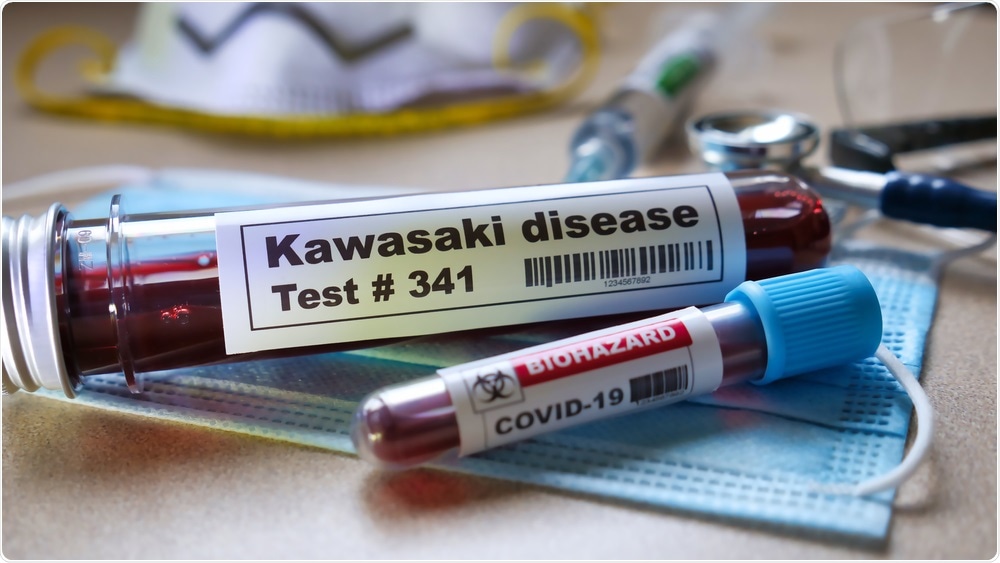Pandemic prevention measures have been associated with lower rates of Kawasaki disease in children across South Korea, indicating it may be transmitted through infectious agents or originate from a response of the immune system.

Kawasaki Disease. Image Credit: Bernard Chantal/Shutterstock.com
An unexpected benefit from COVID-19 measures
A Nationwide Observational Study in Korea has found that the number of cases of Kawasaki disease has dropped significantly when comparing rates before and after pandemic-related measures were instated.
Kawasaki disease is the most common cause of heart disease after birth in children, creating inflammation in blood vessels and particularly in the arteries. Kawasaki disease usually occurs before 5 years old, and affects 20.8 per 100,00 children in the US but is more common among children of Asian descent.
Symptoms associated with Kawasaki disease include fever, rash, red lips, and a bumpy, red tongue with enlarged taste buds. Medical treatment is critical to prevent significant heart problems and the majority of children recover fully following treatment.
The global rate of Kawasaki disease is rising possibly due to more frequent diagnosis and recognition. Nonetheless, countries such as South Korea are particularly affected, as it has the second-highest incidence of Kawasaki disease in the world after Japan.
However, the cause of Kawasaki disease remains unknown. Evidence has suggested it may be an immune response to an acute infectious illness based in part on genetic susceptibilities but this has yet to be proven.
Research published in the American Heart Association's flagship journal, titled Circulation, now indicates that COVID-19 prevention efforts, such as mask-wearing, hand-washing, and physical distancing, decreased the rate of Kawasaki disease in children suggesting it may be caused or transmitted through infectious agents.
Shedding light on Kawasaki disease
The team of South Korean researchers was presented with the unique conditions presented by the COVID-19 pandemic including a reduction in population movement, increased levels of personal hygiene, and sustained levels of physical distancing. Since February 2020, South Korea has implemented strict mask-wearing, periodic school closures, physical distancing, and frequent testing and isolation for people with COVID-19 symptoms.
For clinical researchers, such changes offer a unique opportunity to study a range of diseases under otherwise unusual conditions. Such measures particularly affected children which experience the highest rates of potential exposure at school or in public places that were now restricted, providing a key opportunity to study infectious diseases in children.
Indeed, this was the case for Kawasaki disease. That is, scientists found an unexpected drop in cases when comparing case rates pre- and post-COVID-19 measures.
The team reviewed health records from January 2010 to September 2020 in a South Korean national health insurance database to identify Kawasaki disease cases among children from birth to 19 years old, identifying 53,424 cases of Kawasaki disease during the 10 years of study, of which 83% of cases occurred in children younger than 5 years of age.
Their analysis found the number of Kawasaki disease cases dropped by about 40% after COVID-19 prevention efforts began in Feb. 2020.
Although no changes were observed in cases between 10- to 19-year-olds, the greatest decrease occurred among children up to age 9. Overall, before 2020, the average number of cases of Kawasaki disease between February and September was 31.5 per 100,000 people, compared to 18.8 per 100,000 people for the same months in 2020 during the COVID-19 pandemic.
Environmental transfer of Kawasaki disease
Researchers remain skeptical as to the exact causal mechanism at play. Specifically, whether Kawasaki disease is transmitted between individuals or whether it is caused by an immune reaction in response to infectious agents. Nevertheless, the common factor appears to be that the environment is at least in part the main driver of transmitting Kawasaki disease.
Our findings emphasize the possible impact of environmental triggers on the occurrence of Kawasaki disease. The decrease in the incidence of Kawasaki disease after the implementation of non-pharmaceutical interventions is very clear, and it is unlikely that other independent interventions were accidentally involved."
Jong Gyun Ahn, M.D., Ph.D., Severance Children's Hospital, Yonsei University College of Medicine in Seoul, South Korea
Other benefits were also observed in the general population, including a further reduction in the incidence of Kawasaki disease. Ahn adds. "Additionally, the seasonality of the Kawasaki disease epidemic disappeared in South Korea. It is usually most prevalent in the winter, with a second peak in late spring-summer."
Further studies across different countries could also examine whether similar trends are present. Moreover, although the study did not include individuals that had not submitted insurance claims, further research could go into further detail to include more patients and determine whether other factors also contribute to Kawasaki disease symptoms.
The unparalleled conditions set by COVID-19 prevention measures offer a unique opportunity to study a range of infectious diseases, and how they have decreased over the past year. Such findings could contribute to future screening processes and treatments, ultimately improving the clinical approaches to addressing viral and bacterial infections.
Journal reference:
- Circulation. 2021;143:00–00. DOI: 10.1161/CIRCULATIONAHA.121.054785